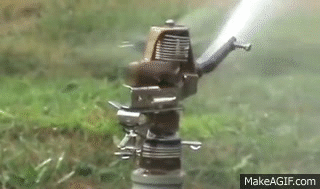Do the sprinkler with D

Rationale:
This lesson will help children identify /d/, the phoneme represented by D. Students will learn to recognize /d/ in spoken words by learning a meaningful representation (the sprinkler). They will also learn the letter symbol D, practice finding /d/ in words, and apply phoneme awareness with /d/ in phonetic cue reading by distinguishing rhyming words from beginning letters.
Materials:
Primary paper and pencil
chart with "Dave’s dancing dog drinks Dr.pepper"
drawing paper and crayons
The Letters are Lost (Scholastic, 1996)
word cards with DOG, DIG, DEER, DENT, DORK, and DRAG
assessment worksheet identifying pictures with /d/ (URL below).
Procedure:
1. Say: Our written language is a secret code. The tricky part is learning what letters stand for—the mouth moves we make as we say words. Today we're going to work on spotting the mouth move /d/. We spell /d/ with letter D. D looks like a stream of water, and /d/ sounds like a sprinkler going back and forth.
2. Let's do the sprinkler with our arms, /d/, /d/, /d/. [Pantomime a sprinkler moving] Notice where your tongue is? (Touching bottom teeth). When we say /d/, we push air down while we move our tongue to the bottom of our mouth.
3. Let me show you how to find /d/ in the word hard. I'm going to stretch hard out in super slow motion and listen for my sprinkler. Hhh-a-r-rdddd. Slower: Hhh-a-a-ar-rr-rd-d. There it was! I felt my tongue touch the bottom of my mouth. I can feel the sprinkler /d/ in hard.
4. Let's try a tongue twister [on chart]. "Dave’s dancing dog drinks Dr.pepper."Everybody say it three times together. Now say it again, and this time, stretch the /d/ at the beginning of the words. "Dd-ave’s dd-ancing dd-og dd-rinks Dd-r.pepper". Try it again, and this time break it off the word: "/d/ ave’s /d/ ancing /d/ og /d/ rinks /D/ r.pepper".
5. [Have students take out primary paper and pencil]. We use letter D to spell /d/. Capital D looks like a stream of water. Let's write the lowercase letter d. Start at the rooftop. Draw a straight line all the way down to the sidewalk, then come up like your drawing a c all the way to the fence. Then complete it like a circle back down to the sidewalk. I want to see everybody's d. After I put a smile on it, I want you to make nine more just like it.
6. Call on students to answer and tell how they knew: Do you hear /d/ in duck or bird? dot or line? hard or soft? Lift or drop? Pudding or cake? Say: Let's see if you can spot the mouth move /d/ in some words. Do the sprinkler if you hear /d/: The, dog, drove, fast, on, dark, dirt, roads, near, town.
7. Say: "Let's look at an alphabet book. The Letters are Lost tells us that about a dog that dug its teeth into the letter D." Read page 5, drawing out /d/. Ask children if they can think of other words with /d/. Ask them to name the dog with the letter D like Darby, Dexter, or dopey. Then have each student write their silly name with invented spelling and draw a picture of their dog. Display their work.
8. Show DOG and model how to decide if it is fog or dog: The D tells me to do the sprinkler, /d/, so this word is ddd-og, dog. You try some: DIG: dig or big? DEER: deer or veer? DENT: dent or cent? DORK: fork or dork? DRAG: drag or brag?
9. For assessment, distribute the worksheet. Students are to complete the partial spellings and color the pictures that begin with D. Call students individually to read the phonetic cue words from step #8.
References:
The Letters are Lost
Ernst, Lisa Campbell. The letters are lost! Scholastic, 1996.
Gulp a Gallon with G: Claire Koenig
http://csk0009.wixsite.com/eportfolio/emergent-literacy
Questions?
Contact: Haley Lushington
